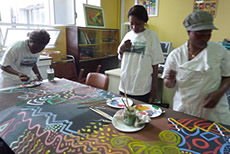30th Anniversary of the UN Voluntary Fund for Victims of Torture
About Us
-
About UN Human Rights
- Mandate
- Mission
-
The High Commissioner
- Volker Türk, High Commissioner
- Nada Al-Nashif, Deputy High Commissioner
- Ilze Brands Kehris, Assistant Secretary-General
-
Past High Commissioners
- Michelle Bachelet Jeria, Chile, 2018-2022
- Mr. Zeid Ra'ad Al Hussein, Jordan, 2014-2018
- Ms. Navanethem Pillay, South Africa, 2008-2014
- Ms. Louise Arbour, Canada, 2004-2008
- Bertrand Ramcharan (Acting High Commissioner)
- Mr. Sergio Vieira de Mello, Brazil, 2002-2003
- Mrs. Mary Robinson, Ireland, 1997-2002
- Mr. José Ayala-Lasso, Ecuador, 1994-1997
- Past Deputy High Commissioners
- Past Assistant Secretaries-General
- What we do
- Where we work
-
Funding and budget
- Our donors
- Funding trends
-
Trust funds
- Special Fund of the OPCAT
- UN Voluntary Fund for Indigenous Peoples
- UN Voluntary Fund for Technical Cooperation
- UN Voluntary Fund on Contemporary Slavery
-
UN Voluntary Fund for Victims of Torture
- Mandate
- About the Fund’s assistance for victims
- Board of Trustees
- How the Fund is managed
- Reports
- Activities
- 40th anniversary
- International Day in Support of Victims of Torture
- Videos
- Feature stories
- How to apply for an annual grant
- Annual grant cycle
- How to report on a grant
- Emergency grants
- How to contribute to the Fund
- Group of Friends
- Evaluation
- Memorial
About Us
-
About UN Human Rights
- Mandate
- Mission
-
The High Commissioner
- Volker Türk, High Commissioner
- Nada Al-Nashif, Deputy High Commissioner
- Ilze Brands Kehris, Assistant Secretary-General
-
Past High Commissioners
- Michelle Bachelet Jeria, Chile, 2018-2022
- Mr. Zeid Ra'ad Al Hussein, Jordan, 2014-2018
- Ms. Navanethem Pillay, South Africa, 2008-2014
- Ms. Louise Arbour, Canada, 2004-2008
- Bertrand Ramcharan (Acting High Commissioner)
- Mr. Sergio Vieira de Mello, Brazil, 2002-2003
- Mrs. Mary Robinson, Ireland, 1997-2002
- Mr. José Ayala-Lasso, Ecuador, 1994-1997
- Past Deputy High Commissioners
- Past Assistant Secretaries-General
- What we do
- Where we work
-
Funding and budget
- Our donors
- Funding trends
-
Trust funds
- Special Fund of the OPCAT
- UN Voluntary Fund for Indigenous Peoples
- UN Voluntary Fund for Technical Cooperation
- UN Voluntary Fund on Contemporary Slavery
-
UN Voluntary Fund for Victims of Torture
- Mandate
- About the Fund’s assistance for victims
- Board of Trustees
- How the Fund is managed
- Reports
- Activities
- 40th anniversary
- International Day in Support of Victims of Torture
- Videos
- Feature stories
- How to apply for an annual grant
- Annual grant cycle
- How to report on a grant
- Emergency grants
- How to contribute to the Fund
- Group of Friends
- Evaluation
- Memorial
Every day, thousands of individuals the world over suffer from torture and its after-effects.
 Combating torture requires a concerted and sustained effort by governments and civil society at the local, national, regional and international level, with the support of the United Nations.
Combating torture requires a concerted and sustained effort by governments and civil society at the local, national, regional and international level, with the support of the United Nations.
In 1981 the UN Voluntary Fund for Victims of Torture was established to receive voluntary contributions from governments, organizations and individuals and to provide humanitarian assistance to victims of torture and members of their families. These contributions are disbursed to a wide variety of non-governmental organizations around the world, which provide rehabilitative services to torture victims. The UNVFVT is now one of the largest humanitarian trust funds in the United Nations.
Since its creation, the Fund has provided essential financial support to many organizations, which in turn have enabled victims to deal with the devastating physical and psychological consequences of torture, in order to rebuild their lives.
This year marks the 30th anniversary of the Fund. This is a time to celebrate achievements and to acknowledge the work of Fund, the non-governmental organizations it has supported, and the generosity of donors who have contributed to the Fund.
The 30th anniversary is also a time to renew our commitment to the creation of a society with zero tolerance for torture.
On this occasion, an exhibition of artwork and artifacts made by victims of torture is being held at the Palais des Nations in Geneva from 21-30 June 2011. The exhibition presents paintings, pictures, sculptures and other types of artistic expression created by the victims as part of their rehabilitation process. The International Day in Support of Victims of Torture is observed on the 26th of June.
Artwork and artifacts from victims of torture
Art therapy is the therapeutic use of creating art, undertaken in partnership with trained professionals, by individuals who have experienced trauma, including torture. Art is a universal language that allows victims of torture to express through imagery what they may have been unable to express in words. Through the creative process, which is followed by reflection with trained therapists, individuals undergoing art therapy are often better able to cope with the stress of traumatic experiences. It is therefore recognized as a means to help heal and empower the victims of torture and can be an important first step in the restoration of their sense of self and the recovery of their dignity, which enables them to rebuild their lives.